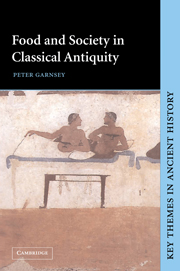Book contents
- Frontmatter
- Contents
- List of illustrations
- Acknowledgements
- Abbreviations
- Preface
- Introduction: Food, substance and symbol
- 1 Diet
- 2 Food and the economy
- 3 Food crisis
- 4 Malnutrition
- 5 Otherness
- 6 Forbidden foods
- 7 Food and the family
- 8 Haves and havenots
- 9 You are with whom you eat
- Conclusion: Choice and necessity
- Bibliographical essay
- Bibliography
- Index
Conclusion: Choice and necessity
Published online by Cambridge University Press: 05 June 2012
- Frontmatter
- Contents
- List of illustrations
- Acknowledgements
- Abbreviations
- Preface
- Introduction: Food, substance and symbol
- 1 Diet
- 2 Food and the economy
- 3 Food crisis
- 4 Malnutrition
- 5 Otherness
- 6 Forbidden foods
- 7 Food and the family
- 8 Haves and havenots
- 9 You are with whom you eat
- Conclusion: Choice and necessity
- Bibliographical essay
- Bibliography
- Index
Summary
Why do people eat what they eat? There are four main factors. The first is physiological. People eat to live and be healthy. This explains why they need food, but not why they choose to eat a particular food or combination of foods. On the whole people have chosen well, and the human race has survived. Errors have been made in ignorance: in antiquity a poison, lead, was ingested through the making of sapa (must), and colostrum in certain social circles was routinely withheld from babies. (These days, nutritionally undesirable choices are sometimes made knowingly, or out of avoidable ignorance.) In general, humans like other animals have selected food that is good for them, and this without any knowledge of nutritional science. Galen, following the Hippocratic tradition, thought that good health depended on the proper blending of the four qualities, hot, cold, dry, wet, corresponding to the four essential humours of the body, blood, black bile, yellow bile, phlegm. Thus precise knowledge of the qualities of the various foods was essential. These are primitive ideas, but the surprising thing is how often Galen was on the right lines. Just as the ancient farmer was not rendered helpless by his ignorance of plant biology, so the crude limitations of Galen's dietetics did not often lead him into absurdity, let alone into giving health-undermining advice.
The second factor is taste. Some foods simply appeal more than others. Humans can survive or flourish on a wide variety of foods. They have more choice than animals have. Some animals are mainly or entirely carnivores or herbivores.
- Type
- Chapter
- Information
- Food and Society in Classical Antiquity , pp. 139 - 143Publisher: Cambridge University PressPrint publication year: 1999



